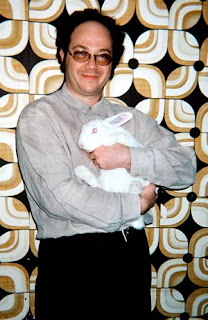Week 6 we learned about the relation between biotechnology and art. Biotechnology is the use of living organisms to develop and produce technologies that can improve human life. As we have previously learned, artists have always been fascinated by science and technology, and have began incorporating them into their works. In an age where biotechnology is expanding, artists have started to enter into laboratories to work directly with biologists and other scientists on a cellular tissue level.
<http://www.mat.ucsb.edu/595M/wp-content/uploads/2012/03/L_004459_1.jpg>
Joe Davis, an artist and research fellow, was a pioneer for biotechnology and art. He set the precedent for other bio artists, even though his ideas, some scientists would consider absurd and crazy. Davis had the idea that genes and genomes can be a new palette for artists, and he set out to create an info gene.
<http://assets.inhabitat.com/wp-content/blogs.dir/1/files/2014/05/Joe-Davis-Ars-Electronica1-537x442.jpg>
Along with biotechnology comes some controversy. Not many galleries are willing to risk publicly displaying genetically engineered bacteria. There was especially a lot of controversy surrounding GFP and transgenic art. GFP is glowing green fluorescent protein that is one of the most important tools used in contemporary bioscience. GFP was first observed in jelly fish but was then later used on mice. Many people believed that this was abuse and unprecedented manipulation of animals. Artist Eduardo Kac created a trangenic art project called the "GFP Bunny" project. He created a GFP Bunny, an albino bunny with red eyes that does not exist in nature.
(The GFP Bunny, Alba, is a transgenic artwork by Eduardo Kac)
Orlan, an artist who we learned about in the Medicine & Art section, created something called the Harlequin Coat. She created a composite organic coat made out of an assemblage of skin pieces from different colours that are made in petri dishes in the lab. Different skin colour samples were taken, which raised the idea of cultural cross breeding, and cross breeding beauty.
<https://www.technologyreview.com/i/images/better.biofuelx299.jpg?sw=1180>
<http://www.visionquest.it/gallery/mostra/1266594454big_OrlanG.jpg>
Ruth West raised some important questions. She asks, is life itself an expressive medium? Oron Catts, an artist and biological art researcher explains that "our cultural understanding of life is compatible with what we see in the lab."
<https://www.linkedin.com/pulse/biotechnology-better-tomorrow-kevin-brown>
West also asked if biotechnology is evaluated differently than other technologies. I believe that the answer is yes. Technological innovations including the printing press and digital media were all groundbreaking innovations that changed the course of history for artists, scientists and humans in general. Biotechnology however, according to Joe Davis, brings "changes on the horizon that are so dramatic and sweeping that all of the revolutions of the so-called digital age will shrink by comparison."
Citations
Kac, Eduardo. "GFP Bunny." Kac. ekac.org, n.d. Web. 3 May. 2016.
Miranda, Carolina A. "Weird Science: Biotechnology as Art Form." Art News. Artnews, 18 Mar. 2013. Web. 3 May. 2016.
Vesna, Victoria. “5 bioart pt1" Lecture. YouTube. Uconlineprogram, 18 Sept. 2013. Web. 3 May. 2016.
Vesna, Victoria. “5 BioArt pt4” Lecture. YouTube. Uconlineprogram, 17 May. 2015. Web. 3 May. 2016.
Vesna, Victoria. “Biotech intro NEW” Lecture. YouTube. Uconlineprogram, 26 Mar. 2012. Web. 3 May. 2016.






I really liked your conclusive reference to Joe Davis, where Biotechnology is said to be so dramatically revolutionary in a soon time. Already, this biotechnology is influencing many scholars, life, and academics on so many different levels; so should it be considered art, science, technology, or everything? I believe contrasted to Week 1 where we learned about the three different worlds of CP Snow, this week's topic truly shows that the three worlds are emerging into one. Thank you for an interesting insight!
ReplyDelete